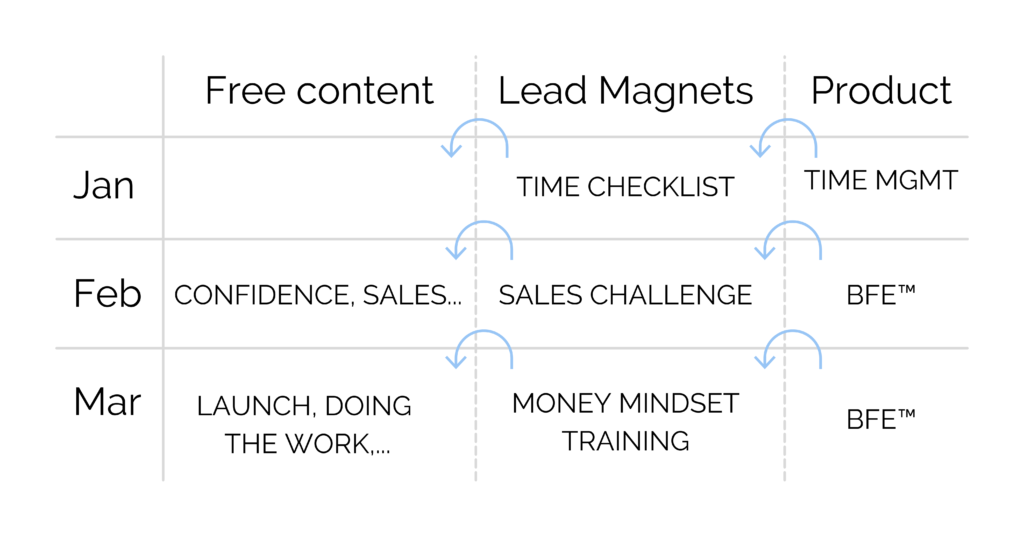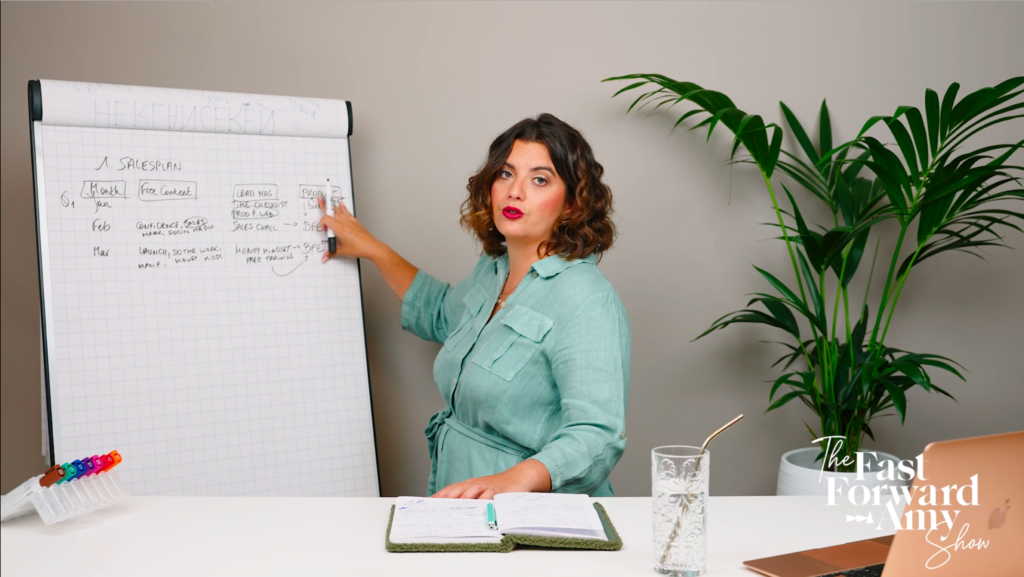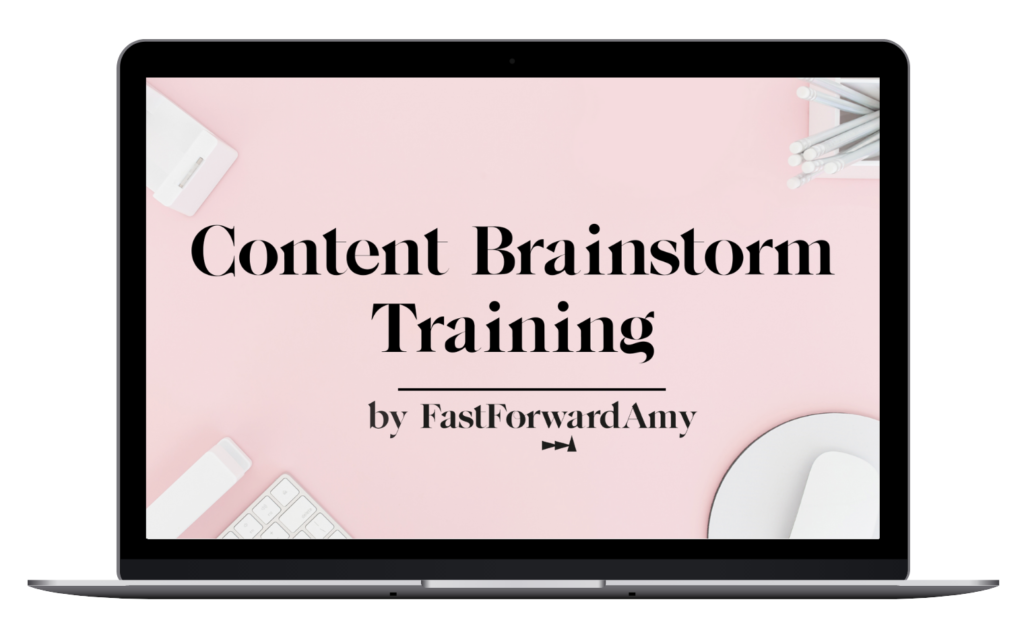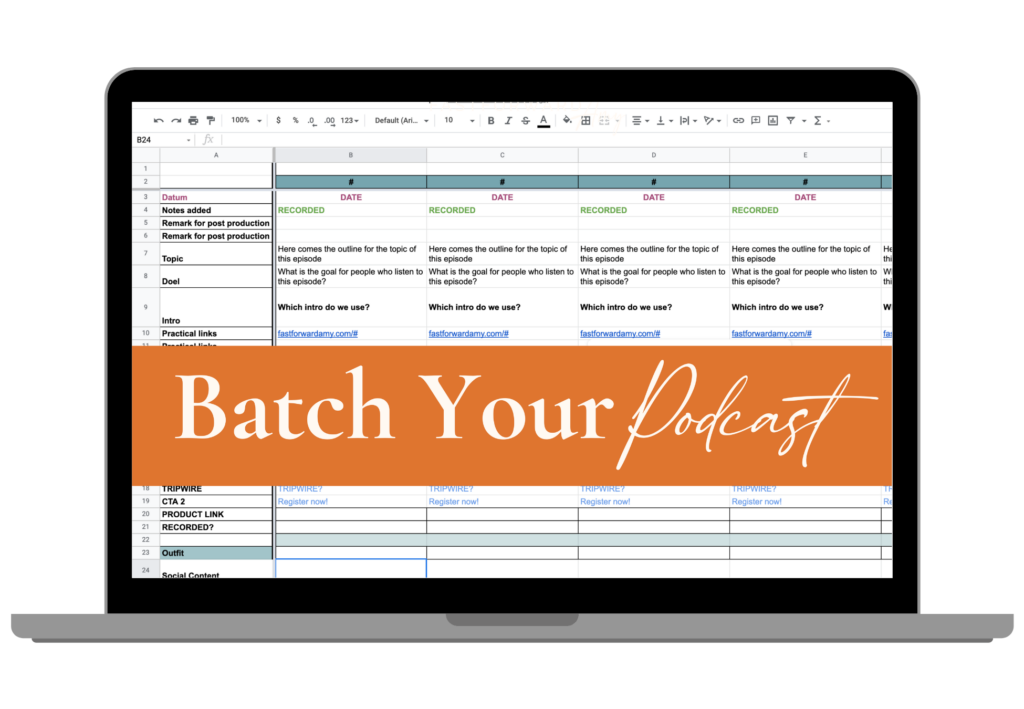Podcasting and content batching are some of my favorite topics, so in this episode I'll talk you through how I batch my podcast!
In 8 steps I'll teach you how to spend less time producing your podcast and more time getting actual results: get new leads and sales every day.
Recently, we recorded 18 episodes in only two days… That's 4 months' worth of content, created in only 2 days.
I used to look at other podcasters and seeing them doing 6 episodes a day, and I thought I would never be able to do that.
Fast forward till today, we're super batching the FastForwardAmy Show, and I want to teach you how we do that, so you can do the same for your show.
Step 1: Outline content based on your sales plan
Preparation is everything, and good preparation starts with your sales plan.
Most people randomly start producing a bunch of content, hoping that this content will somehow bring in new leads and sales.
Instead,
- Start by looking at your product and sales plan,
- work your way backwards to lead magnets and free content,
- ensure that all of your content supports your sales cycle.
I'll use my business to illustrate these 3 steps.
Let's say we'll be launching the Business Freedom Elevator™️ in February and March. That means we will use Q1 (January, February, and March) to hype up the launch.
Note, we're not yet selling anything; we want to BUILD UP towards the launch.

- January: we focus our content on getting people on our email list. To do so, we'll host a webinar on time management combined with a mini-course on time management systems. We start with a low-tier offer, building up to a high-tier offer.
- February: we focus our content on confidence, sales, marketing, and social media. The goal is to highlight sales and the things that lead to sales.
- March: we focus our content on launching, money mindset, and doing the work. At the end of a launch, we see so many people interested, but they still doubt if they'll be able to achieve the results. That's why our content should also be focused on countering potential objections new leads will have in the future.
When you're outlining the topics of your podcast episodes, take a look at your salesplan first and work back from your core offer to define what you should be talking about.
RECAP: start with your product, and based on your core offer, map out the different topics that support your core offer. I recommend you watch the video of this first step to get all the golden details.

Step 2: Speak to your ideal client
If you want your content to be of high value, you should always keep your ideal client in mind.
Ask yourself:
- Who am I talking to?
- What content do they want to consume?
- What value can I present them with?
Once you know who your ideal client is, you'll be able to pinpoint what your content should offer them.
The key elements you need to know about your ideal client are:
- What do they like and love?
- What needs and desires do they have?
- What are their pains and struggles?
- What transformation are they looking for?
Knowing this you'll be able to create podcast content that aligns with their story AND your core offer AND your sales plan.
Step 3: Brainstorm podcast content
You know what you're selling and who you're selling it to. The next step is to figure out what specific content you should use for your batching days.
Create a list or mind map with all of your ideas and write down ANY ideas that come to you. Later down the line, you can filter out the best ideas.
I like to go wild and write out any idea, possible or not, on my whiteboard and afterwards select the best 20% to actually use or apply.
If you need an extra little kick in the butt to start brainstorming, I recommend you check out our Content Brainstorm Training.
It's a free video training on how to come up with content ideas, including a special mind map exercise.
You can access the Content Brainstorm Training here.

Step 4: Find the hooks for your content
The left side of your brain should feel completely satisfied after step 3, so now it's time for some right brain action.
Analyze your content brainstorm, review your ideas and try to find the hooks you can attach to your content.
- Is there a personal story that fits this content?
- Is there a funny anecdote I can share?
- Is there an important life lesson I had to learn before knowing this?
Example: One of the content ideas I've listed is “How I went from broke with a scarcity mindset to millionaire CEO.” I can link this idea to a personal story on how I used to have a 1,000 EUR cash buffer in an envelope in my bedside drawer.
Step 5: Choose your lead magnet
To generate new leads and sales, which I assume is the goal of your podcast, you need people on your email list.
Remember, your email list is your core lead pool whether or not you have a podcast.
Think about what episodes you can link to which lead magnet so you can get your podcast listeners on your email list, too.
Example: In February, I'm turning 29, so let's say I make an episode about “29 Lessons in 29 Years” and launch it around my birthday. The accompanying download could be on confidence to reach a wider audience.
Make sure you vary your content and lead magnets to cater to different client avatars.
Step 6: Outline what you want to talk about
Okay, you know your sales plan and your ideal client. You've brainstormed podcast content, found the right hooks, and you know which lead magnet to link to.
Now it's time for you to organize all of this information in ONE document. And to help you, I'm sharing the Excel file that I use to structure my own podcast recordings super fast.
You can download the Excel file for free via: www.fastforward.com/batchyourpodcast.
Outline the topics you want to talk about, key takeaways, hooks and lead magnets.
I never use complete sentences but primarily keywords to make sure I stay on track and know exactly what I want to teach people.
Step 7: Check your timeline
You're almost ready to call yourself a super batching b*tch! Nice.
Before you hit the finish line, check your timeline.
- Do you have enough time to finish up your lead magnets?
- Do you have a balance between the different topics of your content?
If not, can you move around some topics, so you don't have three episodes on confidence in a row.
Use the document you've set up during the previous step, and add in your timing, launch dates and deadlines.
Step 8: Print your outline and record
Print out your filled-in podcast batching document, or have it next to you on your tablet or laptop when you get to recording.
Having the outline in front of you makes it easier to easily refer to other episodes as you record.
Maybe you thought this article was going to be about all the technical nitty-gritty of podcasting.
If that's what you're looking for, I've created another dedicated guide for you on this: Start Your Podcast, where you'll find everything on the systems and gear you need to start your podcast.
Before you head out, there's one last thing I want you to remember: make sure you put in the effort to prepare for your podcast recording days.
Not having any preparation will make your recordings super slow, and you'll eventually end up like me when I first started: recording content last minute every single week in your pjs…

Prep and batch your recordings to free up time for other business-building activities, and get ready to record every episode with ease.
Good luck, boss!
Watch this episode on YouTube or listen via iTunes, Spotify, Reason, or wherever you get your podcasts, and search for episode 99 of The FastForwardAmy Show.
PS Download my free Batch Your Podcast template to start super batching your podcast recordings.
Get access to the Batch Your Podcast template here.


Leave a Reply